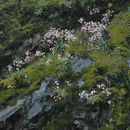Comments
provided by eFloras
The varieties occasionally co-occur. Natural hybrids with Lewisia leeana are known (see discussion under 8. L. leeana).
- license
- cc-by-nc-sa-3.0
- copyright
- Missouri Botanical Garden, 4344 Shaw Boulevard, St. Louis, MO, 63110 USA
Description
provided by eFloras
Taproots gradually ramified distally. Stems ascending to suberect, 10-12(-30) cm. Leaves: basal leaves evergreen, sessile or abruptly or gradually narrowed to broad petiole, blade oblanceolate, obovate, spatulate, or rarely ± linear or ± orbiculate, ± flattened, 3-14 cm, margins entire, crisped, or toothed, apex truncate, emarginate, retuse, or rounded; cauline leaves alternate, intergrading with bracts, blade oblong to ovate, 5-10 mm, margins glandular-toothed, apex acute to occasionally obtuse. Inflorescences dense, paniculate to subumbellate cymes, 10-50-flowered; bracts alternate or opposite proximally, 2 at each flowering node distally, obovate to lanceolate, 2-4 mm, margins glandular-toothed, apex acute. Flowers pedicellate, not disarticulate in fruit; sepals 2, suborbiculate to broadly ovate, 4-6 mm, herbaceous at anthesis, margins glandular-toothed, apex obtuse to truncate; petals 7-10, usually pink-purple with pale and darker stripes, less often white, cream with pink-orange stripes, ± orange, or yellow, oblanceolate, obovate, or spatulate, (8-)12-20 mm; stamens 5-12; stigmas 2-4; pedicel 2-5 mm. Capsules 3-5 mm. Seeds 4-15, 1.5 mm, shiny, smooth.
- license
- cc-by-nc-sa-3.0
- copyright
- Missouri Botanical Garden, 4344 Shaw Boulevard, St. Louis, MO, 63110 USA
Synonym
provided by eFloras
Calandrinia cotyledon S. Watson, Proc. Amer. Acad. Arts 20: 355. 1885; Oreobroma cotyledon (S. Watson) Howell
- license
- cc-by-nc-sa-3.0
- copyright
- Missouri Botanical Garden, 4344 Shaw Boulevard, St. Louis, MO, 63110 USA
Comprehensive Description
provided by North American Flora
Oreobroma cotyledon (S. Wats.) Howell, Erythea 1: 32. 1893
Calandrinia Cotyledon S. Wats. Proc. Am. Acad. 20: 355. 1885.
I^cwisia Cotyledon B. L. Robinson, in A. Gray, Syn. 1-1. N. Am. V: 268. 1897.
Perennial, with a thick taproot and short caudex; basal leaves numerous and fleshy, spatulate, oblanceolate, or obovate, 3-5 cm. long, 1-2 cm. wide, entire or denticulate; scapelike stems several, 2-3 dm. high; stem-leaves bract-like, oblong to ovate, glandular-dentate; inflorescence a corymbiform cyme; bracts lanceolate, glandular-dentate with stalked glands; pedicels short; sepals orbicular, 4 mm. long, many-nerved, the nervis excurrent and glandtipped; petals 10, rose-colored, oblanceolate, 10-12 mm. long; stamens 5-8, the filaments dilated; stigmas 2 or 3; capsule oblong-ovoid, 5 mm. long; seeds 10-20, black, shining, ovoid, 1.5 mm. long.
Type locality: Siskiyou Mountains, California, near head of Illinois River. Distribution: Southwestern Oregon and northern California,
- bibliographic citation
- Percy Wilson, Per Axel Rydberg. 1932. CHENOPODIALES. North American flora. vol 21(4). New York Botanical Garden, New York, NY
Lewisia cotyledon: Brief Summary
provided by wikipedia EN
Lewisia cotyledon is a species of flowering plant in the family Montiaceae known by the common names Siskiyou lewisia and cliff maids. It is native to southern Oregon and northern California, where it grows in rocky subalpine mountain habitat.
- license
- cc-by-sa-3.0
- copyright
- Wikipedia authors and editors

